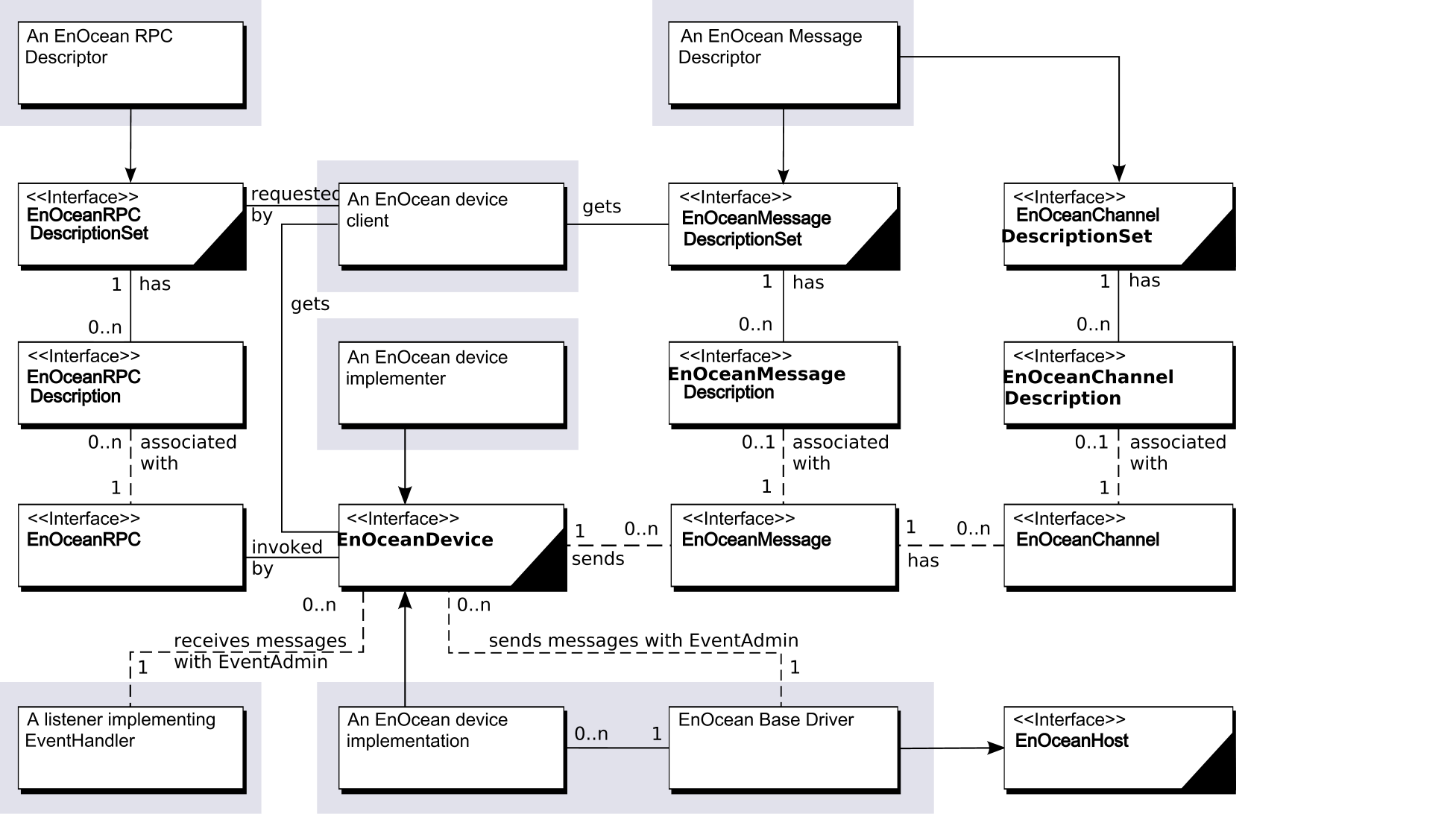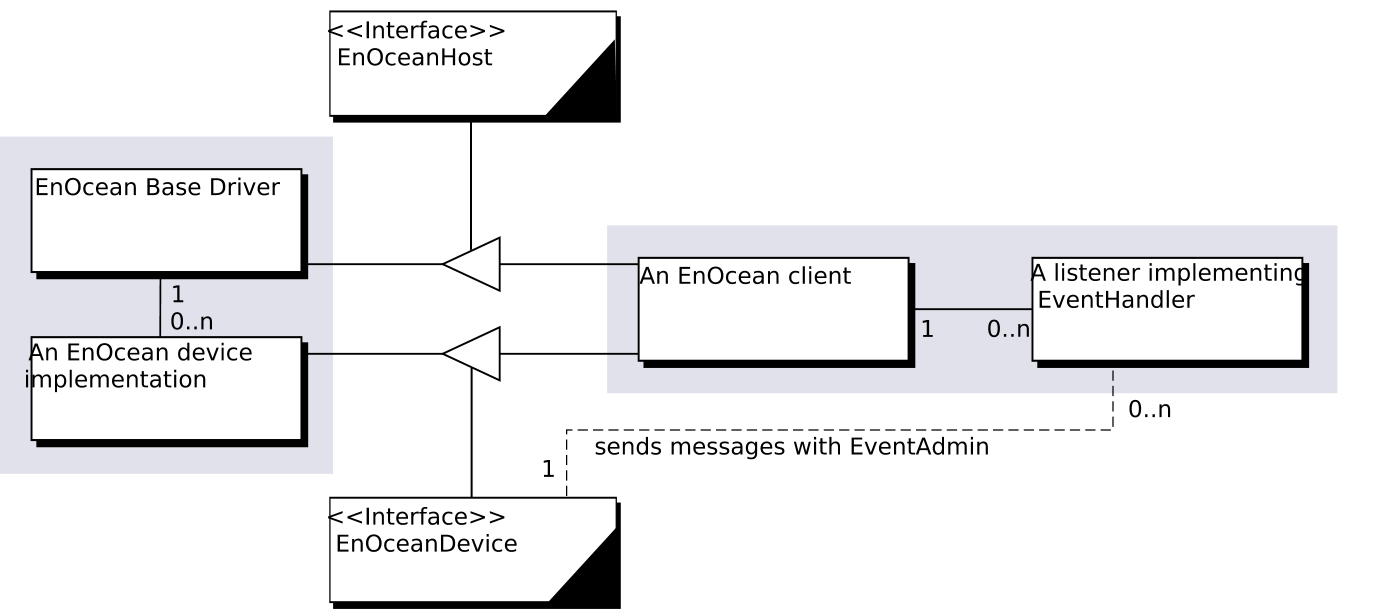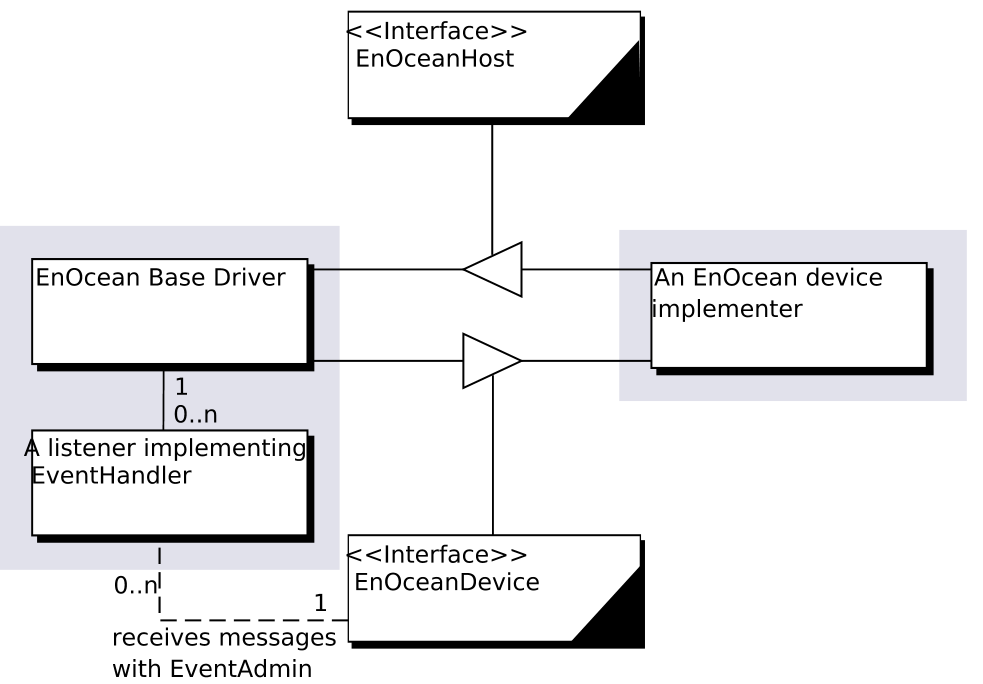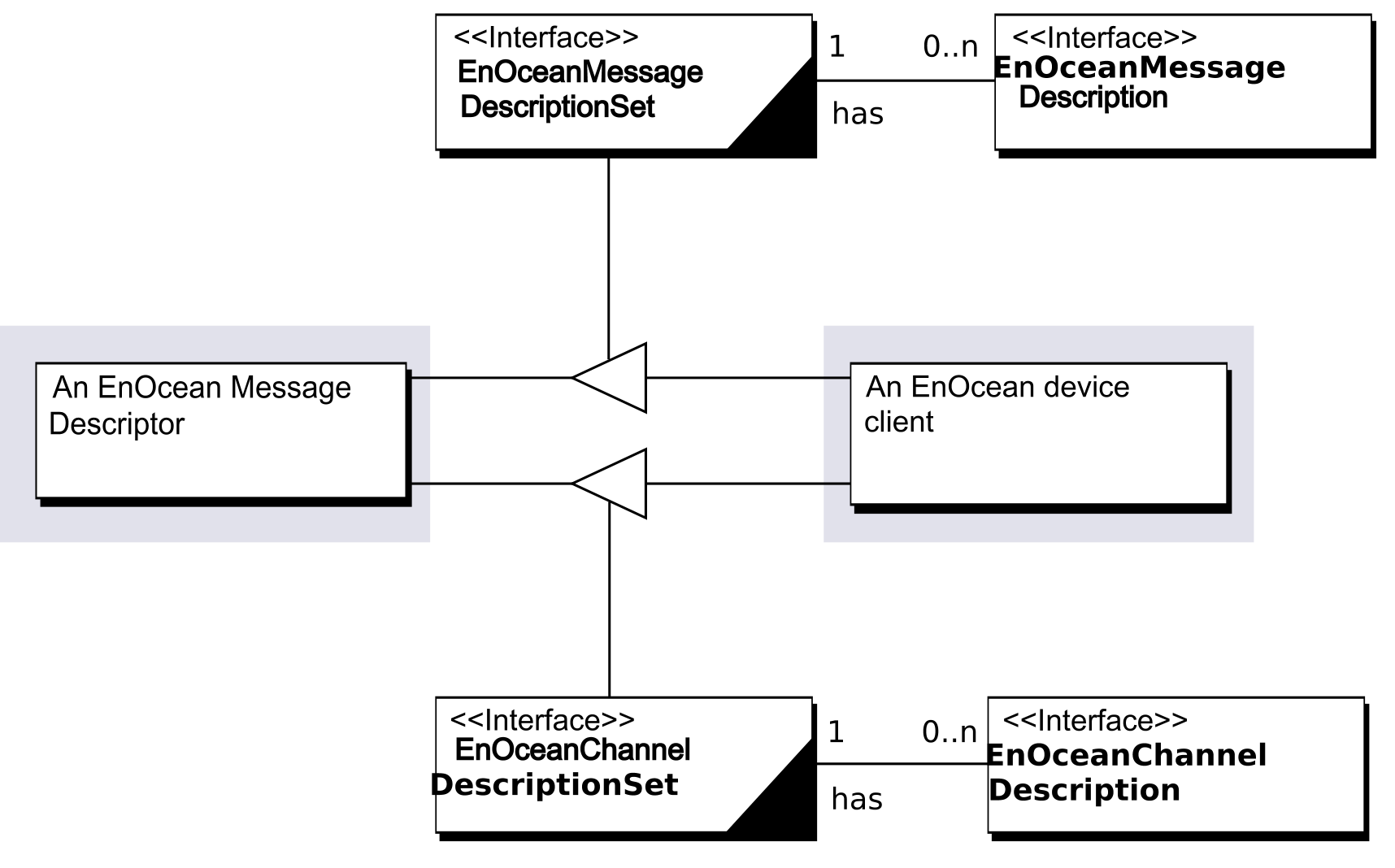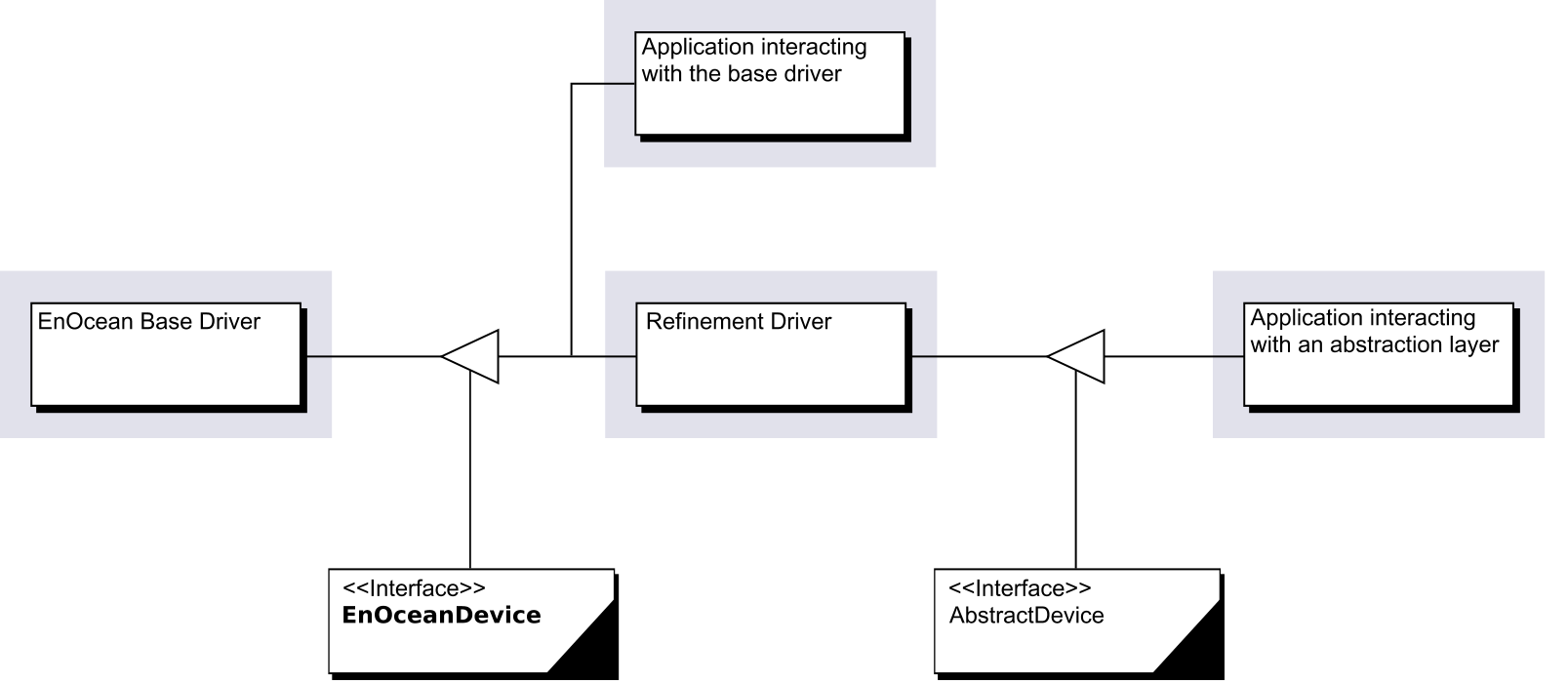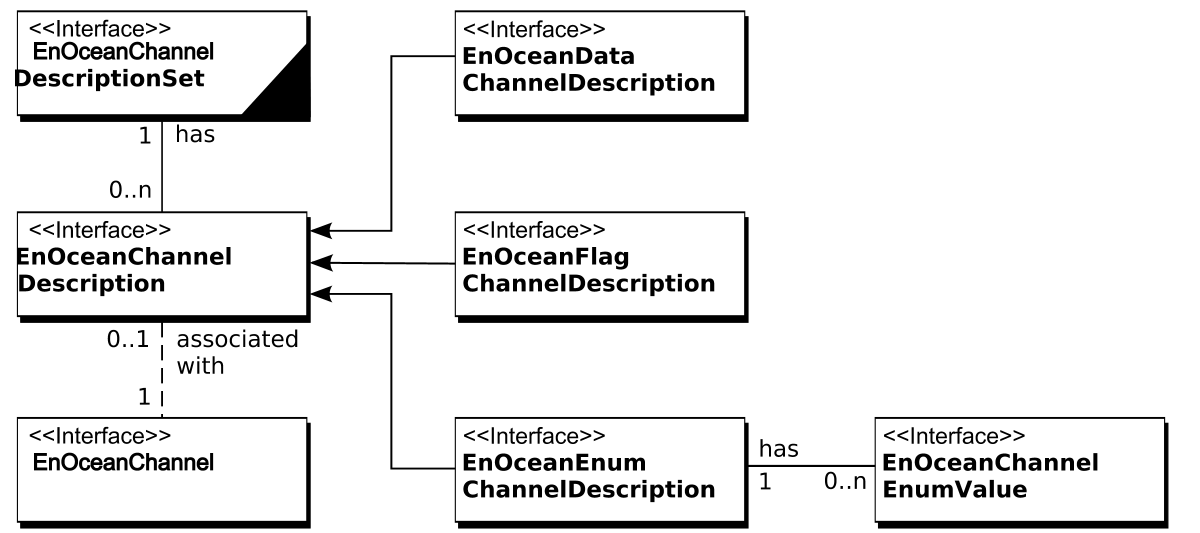EnOcean is a standard wireless communication protocol designed for low-cost and low-power devices by EnOcean Alliance.
EnOcean is widely supported by various types of devices such as smart meters, lights and many kinds of sensors in the residential area. OSGi applications need to communicate with those EnOcean devices. This specification defines how OSGi bundles can be developed to discover and control EnOcean devices on the one hand, and act as EnOcean devices and interoperate with EnOcean clients on the other hand. In particular, a Java mapping is provided for the standard representation of EnOcean devices called EnOcean Equipment Profile (EEPs). See [2] EnOcean Equipment Profiles v2.6.2.
The specification also describes the external API of an EnOcean Base Driver according to Device Access specification.
-
Scope - This specification is limited to general device discovery and control aspects of the standard EnOcean specifications. Aspects concerning the representation of specific or proprietary EnOcean profiles is not addressed.
-
Transparency - EnOcean devices discovered on the network and devices locally implemented on the platform are represented in the OSGi service registry with the same API.
-
Lightweight implementation option - The full description of EnOcean device services on the OSGi platform is optional. Some base driver implementations may implement all the classes including EnOcean device description classes while Implementations targeting constrained devices are able to implement only the part that is necessary for EnOcean device discovery and control.
-
Network Selection - It must be possible to restrict the use of the EnOcean protocols to a selection of the connected devices.
-
Event handling - Bundles are able to listen to EnOcean events.
-
Discover and control EnOcean devices as OSGi services - Available learned (via an EnOcean teach-in procedure) EnOcean external endpoints are dynamically reified as OSGi services on the service registry upon discovery.
-
OSGi services as exported EnOcean devices - OSGi services implementing the API defined here and explicitly set to be exported should be made available to networks with EnOcean-enabled endpoints in a transparent way.
-
EnOcean Base Driver - The bundle that implements the bridge between OSGi and EnOcean networks, see Figure 139.1 on page . It is responsible for accessing the various EnOcean gateway chips on the execution machine, and ensures the reception and translation of EnOcean messages into proper objects. It is also used to send messages on the EnOcean network, using whatever chip it deems most appropriate.
-
EnOcean Host - The EnOceanHost object is a link between the software and the EnOcean network. It represents the chip configuration (gateway capabilities) described in [5] EnOcean System Specification - Security of EnOcean Radio Networks v1.9. It is registered as an OSGi service.
-
EnOcean Device - An EnOcean device. This entity is represented by a EnOceanDevice interface and registered as a service within the framework. It carries the unique chip ID of the device, and may represent either an imported or exported device, which may be a pure transmitter or a transceiver.
-
EnOcean Message - Every EnOcean reporting equipment is supposed to follow a “profile”, which is essentially the way the emitted data is encoded. In order to reflect this standard as it is defined in [2] EnOcean Equipment Profiles v2.6.2, manufacturers are able to register the description of “Messages”, the essence of a profile, along with their associated payload (as Channels). See “EnOcean Channels” below for more information.
-
EnOcean Channel - EnOcean channels are available as an array inside EnOceanMessage objects. They are a useful way to define any kind of payload that would be put inside of an EnOcean Message.
EnOcean Messages and their associated Channels can be described with EnOceanMessageDescription and EnOceanChannelDescription interfaces. Description providers aggregate these descriptions in sets that they register with EnOceanMessageDescriptionSet and EnOceanChannelDescriptionSet interfaces within the framework.
-
EnOcean RPC - An interface that enables the invocation of vendor-specific Remote Procedure Calls and Remote Management Commands. These are particular types of Messages and are not linked to any EnOcean Profile, so that their descriptions are defined and registered in another way. The RPCs are documented via the EnOceanRPCDescription objects gathered into registered EnOceanRPCDescriptionSet services.
-
EnOcean Handler - Enables clients to asynchronously get answers to their RPCs.
-
EnOcean Client - An application that is intended to control EnOcean device services.
-
EnOcean Exception - Delivers errors during EnOceanMessage serialization/deserialization or during execution outside transmission.
To make an EnOcean device service available to EnOcean clients on the OSGi platform, it must be registered under the EnOceanDevice interface within the OSGi framework.
The EnOcean Base Driver is responsible for mapping external devices into EnOceanDevice objects, through the use of an EnOcean gateway. See [1] Pervasive Service Composition in the Home Network. The latter is represented on OSGi framework as an object implementing EnOceanHost interface. EnOcean “teach-in” messages will trigger this behavior, this is called a device import situation, see Figure 139.2 on page .
Client bundles may also expose framework-internal (local) EnOceanDevice instances, registered within the framework, see Figure 139.3 on page . The Base Driver then should emulate those objects as EnOcean devices on the EnOcean network. This is a device export situation, made possible by the use of the 127 virtual base IDs available on an EnOcean gateway. For more information about this process, see Export Situation.
EnOcean clients send RPCs (Remote Procedure Calls) to EnOcean devices and receives RPC responses and messages from them. Messages coming from EnOcean devices are accessible through Event Admin.
RPCs and messages content are specified by EnOcean Alliance or vendor-specific descriptions. Those descriptions may be provided on the OSGi platform by any bundle through the registration of EnOceanRPCDescriptionSet, EnOceanMessageDescriptionSet and EnOceanChannelDescriptionSet services. Every service is a set of description that enables applications to retrieve information about supported RPCs, messages or channels that compose messages.
Most of the functionality described in the operation summary is implemented in an EnOcean base driver. This bundle implements the EnOcean protocol and handles the interaction with bundles that use the EnOcean devices. An EnOcean base driver is able to discover EnOcean devices on the network and map each discovered device into an OSGi registered EnOceanDevice service. It is also the receptor, through EventAdmin service and OSGi service registry, of all the events related to local devices and clients. It enables bidirectional communication for RPC and Channel updates.
Several base drivers may be deployed on a residential OSGi device, one for every supported network technology. An OSGi device abstraction layer may then be implemented as a layer of refinement drivers above a layer of base drivers. The refinement driver is responsible for adapting technology-specific device services registered by the base driver into device services of another model, see AbstractDevice interface in Figure 139.5 on page . In the case of a generic device abstraction layer, the model is agnostic to technologies.
The EnOcean Alliance defines their own abstract model with EnOcean Equipment Profiles and refinement drivers may provide the implementation of all EEPs with EnOcean specific Java interfaces. The AbstractDevice interface of Figure 139.5 on page is then replaced by an EEP specific Java interface in that case. The need and the choice of the abstraction depends on the targeted application domain.
The EnOcean host represents an EnOcean gateway chip. Any EnOcean device service implementation should rely on at least one Gateway Chip in order to send and receive messages on the external EnOcean network. This interface enables standard control over an EnOcean compatible chip. Every EnOceanHost object should at least be identified by its unique chip ID.
The EnOceanHost interface enables OSGi applications to:
-
Get or set gateway metadata (version, name, etc);
-
Reset the gateway chip device;
-
Retrieve a chip ID (derived from EnOcean's BASE_ID) for the given Service PID of a device.
A physical EnOcean device is reified as an EnOceanDevice object within the framework.
An EnOcean device holds most of the natural properties for an EnOcean object: its unique ID, the profile, a friendly name, its security information, and its available RPCs – along with the associated getters (and setters when applicable). All those properties MUST be persistent across restart so that teach-in procedures are made only once.
It also holds methods that reflect the natural actions a user application may physically trigger on such a device: send a message to the device, send a teach-in message to the device, or switch the device to learning mode.
Every EnOcean Device keeps a service PID property that is assigned either by the base driver or by any service-exporting bundle. The property value format is free and the value must be unique on the framework.
The properties on which EnOceanDevice services can be filtered on are: the device's service PID and chip ID, and its profile identifiers (RORG / FUNC / TYPE integers).
The EnOceanDevice also keeps security features as defined in the EnOcean Security Draft, [5] EnOcean System Specification - Security of EnOcean Radio Networks v1.9, which allow for a security level format (integer mask), an encryption key and/or a rolling authentication code.
The EnOceanDevice service MUST also be registered with the
DEVICE_CATEGORY service property, see Device Service Registration, that describes a
array of categories to which the device belongs. One value MUST be
EnOcean which is specified in DEVICE_CATEGORY.
Values for the additional service properties,
DEVICE_DESCRIPTION, DEVICE_SERIAL as defined
in Device Service Registration, are not
specified here as no description nor application-level serial number are
provided in the EnOcean standard protocol.
In import situations, the device's chip ID is uniquely set by the Base Driver, according to the one present in the teach-in message that originated the Device's creation. The service PID, see [7] Persistent Identifier (PID), should also be generated and deterministically derived from the chip ID to allow reconstruction of a device without a new teach-in process after a framework restart.
In export situations:
-
The registering Client bundle sets the service PID of the EnOceanDevice object by itself, in a unique manner, and registers that object.
-
The chip ID (this device's EnOcean source ID when it issues messages) will be allocated by the Base Driver. The latter keeps a dictionary of the currently allocated chip IDs. The Client bundle must also set an ENOCEAN_EXPORT property in the registered device's Property Map.
The standard way to programmatically retrieve an exported chip ID from a given service PID is by using EnOceanHost's dedicated interface for this use.
The Base Driver MUST ensure the persistence of the CHIP_ID:SERVICE_PID mapping.
As an application developer, please refer to the documentation of your Base Driver to know its policies concerning exported chip ID updating, deletion and exhaustion.
The EnOceanDevice interface enables client bundles to:
-
Get or set the security features of the device in a protected way;
-
Retrieve the currently paired devices in the case of a receiver, as a collection of device IDs;
-
Get the ID-based list of currently available RPCs for the device, as a Map of {manufacturerID:[functionId1, functionId2,...]};
-
Invoke RPCs onto the device, through the invoke(EnOceanRPC,EnOceanHandler) call.
EnOcean Messages are at the core of the EnOcean application layer as a whole and the EnOcean Equipment Profile specification, [2] EnOcean Equipment Profiles v2.6.2, in particular. Every exchange of information within EnOcean networks is done with a dedicated message. The EnOceanMessage interface provides a set of getters. The latter enables OSGi applications to get the information contained in the payload of an EnOcean message and defined as data and optional data of the EnOcean Serial Protocol Type 1 (RADIO) message (see Table 2 in Section "1.6.1 Packet description" of [4] EnOcean System Specification - EnOcean Serial Protocol v1.17).
This model enables reading both the EnOcean radio telegram data and the associated metadata that may be attached to it in a single object, EnOceanMessage.
In case the 'Optional Data' section gets missing at the lowest level (the radio access layer not following ESP protocol for instance) it is the responsibility of the Base Driver to mock the missing field's (dBm, destinationID, …) values.
Any EnOceanMessage object creation will be mirrored to Event Admin.
Details about the available topics, filters and properties can be found in Event API.
EnOceanMessage objects will be created only if the originating device has already been registered in the OSGi Service Registry, along with profile information.
The RORG of a message defines its shape and generic type; all the RORGs are defined in the EnOcean Radio Specification.
An addressed message will be encapsulated into an Addressed Telegram (ADT) by the base driver transparently; this means that from the application level, it will be represented under its original RORG, but with a valid destinationID.
A particular EnOcean Equipment Profile message is identified by three numbers: its RORG, and its FUNC, TYPE and EXTRA subtypes. In EnOcean, a (RORG, FUNC, TYPE) triplet is enough to identify a profile; though an EXTRA identifier is sometimes needed to identify a particular message layout for that profile.
Those identifiers allow for retrieving EnOceanMessageDescription objects within a registered EnOceanMessageDescriptionSet, which give the application more information to parse the message.
The methods available in the EnOceanMessage interface are:
-
Identification methods, retrieving the message's profile, sender ID, optional destination ID, status;
-
A method to get the raw bytes of payload data in the message. This data can then be passed to the deserializer of the EnOceanMessageDescription object to be converted to EnOceanChannel, which may -again- be documented (through EnOceanChannelDescription objects) or not.
-
Link quality information read-only methods that mirror some of the 'Optional Data' header information.
EnOceanMessageDescription objects exposes only two methods:
-
deserialize(byte[]): makes the user able to deserialize the payload bytes of a raw EnOceanMessage object, into a collection of EnOceanChannel objects.
-
serialize(EnOceanChannel[]): serializes the input EnOceanChannel objects into a collection of bytes.
The EnOceanChannel interface is the first step of an abstraction to generate or interpret EnOceanMessage channels with plain Java types.
The simple EnOceanChannel interface provides a way to separate the different fields in a message payload, knowing their offset and size in the byte array that constitutes the full message's payload.
At the EnOceanChannel level, the only way to get/set the information contained in the channel is through a pair of getRawValue() and setRawValue(byte[]) methods, which act on plain bytes.
Those bytes are meant right-aligned, and the number of those bytes is the size of the data field, floored up to the next multiple of 8. For instance, a 3-bit long channel would be encoded on one byte, all the necessary information starting from bit 0.
Every EnOceanMessage as described in the EEP Specification contains a various amount of channels, each of them being identified by their unique ID.
This ID, or channelID, is constituted of the “Shortcut” field of this channel from the EEP 2.5 Specification, [2] EnOcean Equipment Profiles v2.6.2, and a number fixed by the order of appearance of such a “Shortcut” in the specification.
This unique identifier links a Channel to an EnOceanChannelDescription object that provides more information to encode and decode that channel's information; see below for more details. This enables for loose coupling of the raw Channel itself and a richer, 3rd-party provided, information.
As an example, if the platform being developed is an electronic display that waits for Messages from a well-known temperature sensor, the Client bundle on the platform may interpret the Temperature Channels in every Temperature Message without needing an appropriate TemperatureChannelDescription object; it may directly cast and convert the Byte[] array of every received message to a properly valued Double and display that.
Otherwise, it could as well use the channelID to get a TemperatureChannelDescription object that would properly handle the deserialization process from the raw bytes to a proper, physical unit-augmented, result.
The EnOceanChannelDescription interface enables the description of all the various channels as specified in the EnOcean specification, as well as the description of channels issued by 3rd party actors.
Those description objects are retrieved from the registered EnOceanChannelDescriptionSet interface using an unique ID known as the channelID.
Here are the Channel types defined in this specification:
-
TYPE_RAW: A collection of bytes. This type is used when the description is not provided, and is thus the default. For this type, the deserialize(byte[]) call actually returns a byte[] collection. The encryption key or a device ID on 4 bytes are examples of such raw types.
-
TYPE_DATA: A scaled physical value. Used when the data can be mapped to a physical value; for instance, the 'WND – Wind Speed' channel is a raw binary value, in a range from 0 to 255, that will be mapped as a wind speed between 0 and 70 m/s. For this type, the deserialize(byte[]) call actually returns a Double value.
-
TYPE_FLAG: A boolean value. Used when the Channel value can be either 1 or 0. The “Teach-In” Channel is a well-known example; this 1-bit field may either be 0 or 1, depending whether the Message is a teach-in one or not. For this type, the deserialize(byte[]) call actually returns a Boolean value.
-
TYPE_ENUM: An enumeration of possible values. Used when the Channel can only take a discrete number of values. More complicated than TYPE_FLAG, enumerated types may have thresholds: for instance, the A5-30 “Digital Input- Input State (IPS)” channel is a 8-bit value which means “Contact closed” between 0 and 195, and “Contact open” from 196 to 255. For this type, the deserialize(byte[]) call actually returns an EnOceanChannelEnumValue object.
According to the channel type, the actual description object should implement one of the following specialized interfaces. This will ease the use of casting to the specialized interfaces on documented channels.
The EnOceanDataChannelDescription interface inherits from EnOceanChannelDescription interface.
Two more methods give access to the integer input domain of the data channel (such as 0-255) and to the floating-point output range of it (such as -30.0°C – 24.5°C). A method is also present to retrieve the physical unit of the channel. The serialize(Object) and deserialize(byte[]) methods are implemented to easily convert from the raw byte[] collection to a Double, and vice versa.
Here are a few samples of such Channels:
Table 139.1 EnOcean Data Channel Description example
| Short | Description | Possible implemented name | Domain | Range | Unit |
|---|---|---|---|---|---|
| TMP | Temperature | TemperatureScaledChannel_X | 0..255 | -10°..+30° | °C |
| HUM | Humidity | HumidityScaledChannel_X | 0..250 | 0..100 | % |
The EnOceanFlagChannelDescription interface inherits from the EnOceanChannelDescription interface.
Those channels, are typically used for On/Off reporting values (like a switch); they have no additional methods, though the deserialize(byte[]) method converts the input bit into a proper Boolean object.
The EnOceanEnumChannelDescription interface inherits from the EnOceanChannelDescription interface.
The additional method provided to this interface is getPossibleValues(), which returns an array of the available EnOceanChannelEnumValue objects accessible to this channel. Every EnOceanChannelEnumValue object contains its integer input range and a String identifier that defines its meaning.
The serialize(Object) and deserialize(byte[]) methods of an EnOceanEnumChannelDescription object thus convert an integer input value (say, 156) to an EnOceanChannelEnumValue, and vice versa.
Here is an example that shows the input range and the associated EnOceanChannelEnumValue:
Table 139.2 EnOcean Enumerated Channel Description example
| Device profile | EnOceanChannelEnumValue | Start | Stop | Meaning |
|---|---|---|---|---|
|
Fan speed stage switch |
FanStageSwitch_Stage3 | 0 | 144 | Fan speed: Stage 3 |
| FanStageSwitch_Stage2 | 145 | 164 | Fan speed: Stage 2 | |
| FanStageSwitch_Stage1 | 165 | 189 | Fan speed: Stage 1 | |
| FanStageSwitch_Stage0 | 190 | 209 | Fan speed: Stage 0 |
Remote Management is a feature which allows EnOcean devices to be configured and maintained over the air using radio messages.
The Remote Procedure Calls, or RPCs - as defined by the EnOcean Remote Management specification, [3] EnOcean System Specification - Remote Management v2.0 - are not related to any EnOcean Equipment Profile.
Note that EnOcean Remote Commissioning is detailed in an additional EnOcean document, [6] EnOcean Remote Commissioning Summary v1.0.
An EnOceanRPC object enables client bundles to remotely manage EnOcean devices using already defined behavior.
RPCs are defined by a MANUFACTURER_ID (11 bits, 0x7FF for the EnOcean alliance) and a unique FUNCTION_ID code on 12 bits.
RPCs are called directly onto an EnOceanDevice object via the invoke(EnOceanRPC,EnOceanHandler) method, which accepts also a non-mandatory EnOceanHandler object as a parameter to retrieve the asynchronous answer.
Broadcasted RPCs can be addressed directly to the Base Driver using the relevant Event Admin topic; see Event API.
Responses to RPCs are processed by the driver and sent back to a handler using notifyResponse(EnOceanRPC,byte[]) method when an EnOceanHandler is passed to the base driver.
All discovered EnOcean devices in the local networks are registered under EnOceanDevice interface within the OSGi framework. Every time an EnOcean device appears or quits the network, the associated OSGi service is registered or unregistered in the OSGi service registry. Thanks to the EnOcean Base Driver, the OSGi service availability in the registry mirrors EnOcean device availability on EnOcean network, [1] Pervasive Service Composition in the Home Network.
Thanks to service events, a bundle is able to track the addition, modification and removal of an EnOceanDevice service.
The following example shows using a ServiceTracker to track EnOceanDevice services.
ServiceTracker<EnOceanDevice, EnOceanDevice> enOceanTracker =
new ServiceTracker<>(bundleContext, EnOceanDevice.class, null);
enOceanTracker.open(); // open the tracker
...
// get a snaphot of the current EnOceanDevice services
EnOceanDevice[] enOceanDeviceSnapshot =
enOceanTracker.getServices(new EnOceanDevice[0]);
...
enOceanTracker.close(); // close the trackerEnOcean events must be delivered to the EventAdmin service by the
EnOcean implementation, if present. EnOcean event topic follow the
following form:
org/osgi/service/enocean/EnOceanEvent/SUBTOPIC.
MESSAGE_RECEIVED and RPC_BROADCAST are the
two available subtopics.
Properties (every event may dispatch some or all of the following properties):
-
CHIP_ID – . The chip ID of the sending device.
-
service.pid– The service PID of the exported device. -
RORG – The RORG (Radio Telegram Type) of the sending device.
-
FUNC – The FUNC profile identifier of the sending device.
-
TYPE – The TYPE profile identifier of the sending device.
-
PROPERTY_MESSAGE – The EnOceanMessage object associated with this event.
-
PROPERTY_EXPORTED – The presence of this property means that this message has actually been exported from a locally implemented EnOcean Device.
This event is used whenever an RPC is broadcasted on EnOcean networks, in IMPORT or EXPORT situations.
Properties (every event may dispatch some or all of the following properties):
-
MANUFACTURER_ID – The RPC's manufacturer ID.
-
FUNCTION_ID – The RPC's function ID .
-
PROPERTY_EXPORTED – The presence of this property means that this RPC has actually been exported from a locally implemented EnOcean Device.
-
PROPERTY_RPC – The EnOceanRPC object associated with this event.
The EnOceanException can be thrown and holds information about the different EnOcean layers. Here below, ESP stands for EnOcean Serial Protocol. The following errors are defined:
-
ESP_UNEXPECTED_FAILURE – Operation was not successful.
-
ESP_RET_NOT_SUPPORTED – The ESP command was not supported by the driver.
-
ESP_RET_WRONG_PARAM – The ESP command was supplied wrong parameters.
-
ESP_RET_OPERATION_DENIED – The ESP command was denied authorization.
-
INVALID_TELEGRAM – The message was invalid.
It is recommended that
ServicePermission[EnOceanDevice|EnOceanHost, REGISTER|GET] be
used sparingly and only for bundles that are trusted.
EnOcean Package Version 1.0.
Bundles wishing to use this package must list the package in the Import-Package header of the bundle's manifest. This package has two types of users: the consumers that use the API in this package and the providers that implement the API in this package.
Example import for consumers using the API in this package:
Import-Package: org.osgi.service.enocean; version="[1.0,2.0)"
Example import for providers implementing the API in this package:
Import-Package: org.osgi.service.enocean; version="[1.0,1.1)"
-
EnOceanChannel- Holds the raw value and channel identification info of an EnOceanChannel. -
EnOceanDevice- This interface represents a physical device that communicates over the EnOcean protocol. -
EnOceanEvent- Constants for use in EnOcean events. -
EnOceanException- This class contains code and definitions necessary to support common EnOcean exceptions. -
EnOceanHandler- The interface used to get callback answers from a RPC or a Message. -
EnOceanHost- This interface represents an EnOcean Host, a device that offers EnOcean networking features. -
EnOceanMessage- Holds the necessary methods to interact with an EnOcean message. -
EnOceanRPC- A very basic interface for RPCs.
Holds the raw value and channel identification info of an EnOceanChannel.
This interface represents a physical device that communicates over the EnOcean protocol.
Property name for the mandatory CHIP_ID of the device
Property name for the mandatory DEVICE_CATEGORY of the device
Property name that defines if the device is exported or not. If present, the device is exported.
Property name for the radiotelegram functional type of the profile associated with this device.
Property name for the manufacturer ID that may be specified by some teach-in messages.
Property name for the radiotelegram main type of the profile associated with this device.
Property name for the security level mask for this device. The format of that mask is specified in EnOcean Security Draft.
Property name for the radiotelegram subtype of the profile associated with this device.
Returns the current encryption key used by this device.
The current encryption key, or null.
Gets the list of devices the device already has learned.
The list of currently learned device's CHIP_IDs.
Get the current rolling code of the device.
The current rolling code in use with this device's communications.
Retrieves the currently available RPCs to this device; those are stored using their manfufacturerId:commandId identifiers.
A list of the available RPCs, in a
Map<Integer, Integer[]> form.
The EnOcean security level format, or 0 as default (no security)
Sends an RPC to the remote device.
IllegalArgumentException–
the encryption key to be set.
Sets the encryption key of the device.
the EEP func of the device;
Manually sets the EEP FUNC of the device.
the desired state: true for learning mode, false to disable it.
Switches the device into learning mode.
the rolling code to be set or initiated.
Sets the rolling code of this device.
Constants for use in EnOcean events.
Property key used to tell apart messages that are exported or imported.
Property key for the EnOceanMessage object embedded in an event.
Property key for the EnOceanRPC object embedded in an event.
Main topic for all OSGi dispatched EnOcean messages, imported or exported.
This class contains code and definitions necessary to support common EnOcean exceptions. This class is mostly used with low-level, gateway-interacting code : EnOceanHost.
Operation is not supported by the target device.
One of the parameters was badly specified or missing.
exception error description
Constructor for EnOceanException
the error code.
the description.
Constructor for EnOceanException
The interface used to get callback answers from a RPC or a Message.
the original EnOceanRPC that originated this answer.
the payload of the response; may be deserialized to an EnOceanRPC object.
Notifies of the answer to a RPC.
This interface represents an EnOcean Host, a device that offers EnOcean networking features.
The unique ID for this Host: this matches the CHIP_ID of the EnOcean Gateway Chip it embodies.
repeater level to disable repeating; this is the default.
repeater level to repeat every telegram at most once.
repeater level to repeat every telegram at most twice.
Returns the chip's API version info (cf. ESP3 command 0x03: CO_RD_VERSION)
a String object containing the API version info.
EnOceanException– if any problem occurs.
Returns the chip's application version info (cf. ESP3 command 0x03: CO_RD_VERSION)
a String object containing the application version info.
EnOceanException– if any problem occurs.
Gets the BASE_ID of the chip, if set (cf. ESP3 command 0x08: CO_RD_IDBASE)
the BASE_ID of the device as defined in EnOcean specification
EnOceanException– if any problem occurs.
Retrieves the CHIP_ID associated with the given servicePID, if existing on this chip.
the associated CHIP_ID of the exported device.
EnOceanException– if any problem occurs.
Gets the current repeater level of the host (cf. ESP3 command 0x0A: CO_RD_REPEATER)
one of the Repeater Level constants as defined above.
EnOceanException– if any problem occurs.
Reset the EnOcean Host (cf. ESP3 command 0x02: CO_WR_RESET)
EnOceanException– if any problem occurs.
to be set.
Sets the base ID of the device, may be used up to 10 times (cf. ESP3 command 0x07: CO_WR_IDBASE)
EnOceanException– if any problem occurs.
Holds the necessary methods to interact with an EnOcean message.
Gets the bytes corresponding to the whole message, including the CRC. The generated byte[] array may be sent to an EnOcean gateway and is conform to EnOcean Radio Protocol.
The serialized byte list corresponding to the binary message.
Returns the average RSSI on all the received subtelegrams, including redundant ones.
The average RSSI perceived.
Returns the payload bytes of this message.
corresponding value.
Returns the security level of this message, as specified in the 'Security of EnOcean Radio Networks' draft, section 4.2.1.3.
The security level format.
Gets the current EnOcean status of the Message. The 'status' byte is actually a bitfield that mainly holds repeater information, teach-in status, and more or less information depending on the radiotelegram type.
the current EnOcean status of this message.
Returns the number of subtelegrams (usually 1) this Message carries.
The number of subtelegrams in the case of multiframe messages.
A very basic interface for RPCs.
The Function ID property string, used in EventAdmin RPC broadcasting.
The Manufacturer ID property string, used in EventAdmin RPC broadcasting.
Gets the current payload of the RPC.
the payload, in bytes, of this RPC.
Sets the RPC's senderID. This member has to belong to EnOceanRPC interface, for the object may be sent as a standalone using EventAdmin for instance.
sender id.
EnOcean Descriptions Package Version 1.0.
Bundles wishing to use this package must list the package in the Import-Package header of the bundle's manifest. This package has two types of users: the consumers that use the API in this package and the providers that implement the API in this package.
Example import for consumers using the API in this package:
Import-Package: org.osgi.service.enocean.descriptions; version="[1.0,2.0)"
Example import for providers implementing the API in this package:
Import-Package: org.osgi.service.enocean.descriptions; version="[1.0,1.1)"
-
EnOceanChannelDescription- Public and registered description interface for a channel. -
EnOceanChannelDescriptionSet- This interface represents an EnOcean Channel Description Set. -
EnOceanChannelEnumValue- This transitional interface is used to define all the possible values taken by an enumerated channel. -
EnOceanDataChannelDescription- Subinterface of EnOceanChannelDescription that describes physical measuring channels. -
EnOceanEnumChannelDescription- Subinterface of EnOceanChannelDescription that describes enumerated channels. -
EnOceanFlagChannelDescription- Subinterface of EnOceanChannelDescription that describes boolean channels. -
EnOceanMessageDescription- This interface represents an EnOcean Message Description. -
EnOceanMessageDescriptionSet- This interface represents an EnOcean Message Description Set.
Public and registered description interface for a channel. Encompasses all the possible subtypes for a channel.
The unique ID of this EnOceanChannelDescription object.
A DATA channel maps itself to a Double value representing a physical measure.
An ENUM channel maps itself to one between a list of discrete EnOceanChannelEnumValue "value objects".
A FLAG channel maps itself to a Boolean value.
A RAW channel is only made of bytes.
the right-aligned raw bytes.
Tries to deserialize a series of bytes into a documented value object (raw bytes, Double or EnOceanChannelEnumValue. Of course this method will be specialized for each EnOceanChannelDescription subinterface, depending on the type of this channel.
a value object.
IllegalArgumentException–
Retrieves the type of the channel.
one of the above-described types.
This interface represents an EnOcean Channel Description Set. EnOceanChannelDescriptionSet is registered as an OSGi Service. Provides a method to retrieve the EnOceanChannelDescription objects it documents.
the unique string identifier of the description object.
Retrieves a EnOceanChannelDescription object according to its identifier.
The corresponding EnOceanChannelDescription object, or null.
IllegalArgumentException– if the supplied String is invalid, null,
or other reason.
This transitional interface is used to define all the possible values taken by an enumerated channel.
A non-mandatory description of what this enumerated value is about.
the description of this channel.
Subinterface of EnOceanChannelDescription that describes physical measuring channels.
The start of the raw input range for this channel.
the domain start.
The end of the raw input range for this channel.
the domain stop.
The scale start at which this channel will be mapped to (-20,0°C for instance)
the range start.
The scale stop at which this channel will be mapped to (+30,0°C for instance)
the range stop.
Subinterface of EnOceanChannelDescription that describes enumerated channels.
Subinterface of EnOceanChannelDescription that describes boolean channels.
This interface represents an EnOcean Message Description.
to be deserialized.
Deserializes an array of bytes into the EnOceanChannels available to the payload, if possible.
deserialized value.
IllegalArgumentException– if the actual instance type of the
message is not compatible with the bytes it is fed with (RORG to
begin with).
the message description containing the RORG, (and the FUNC, and the TYPE if available), as well as, the EEP's "title" (e.g. for F60201: Rocker Switch, 2 Rocker; Light and Blind Control - Application Style 1).
to be serialized.
Serializes a series of EnOceanChannel objects into the corresponding byte[] sequence.
serialized value.
IllegalArgumentException– if the given channels is null.
This interface represents an EnOcean Message Description Set. EnOceanMessageDescriptionSet is registered as an OSGi Service. Provides method to retrieve the EnOceanMessageDescription objects it documents.
the radio telegram type of the message.
The func subtype of this message.
The type subselector.
Some extra information; some EnOceanMessageDescription objects need an additional specifier. If not needed, has to be set to -1.
Retrieves a EnOceanMessageDescription object according to its identifiers. See EnOcean Equipment Profile Specification for more details.
The EnOceanMessageDescription object looked for, or null.
IllegalArgumentException– if there was an error related to the
input arguments.
[1]Pervasive Service Composition in the Home NetworkBottaro, A., Gérodolle, A., Lalanda, P., 21st IEEE International Conference on Advanced Information Networking and Applications (AINA-07), Niagara Falls, Canada, May 2007
[2]EnOcean Equipment Profiles v2.6.2EnOcean Alliance, https://www.enocean-alliance.org/en/enocean_standard/, November 19, 2014
[5]EnOcean System Specification - Security of EnOcean Radio Networks v1.9EnOcean Alliance, July 26, 2013
[6]EnOcean Remote Commissioning Summary v1.0EnOcean Alliance, https://www.enocean-alliance.org/en/downloads/, December 01, 2014
